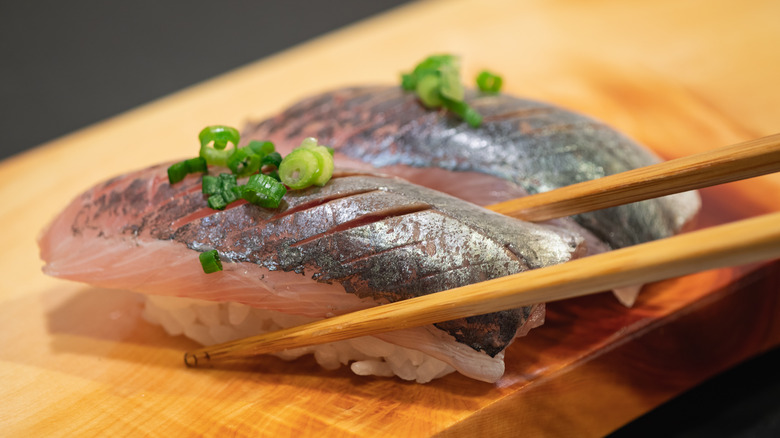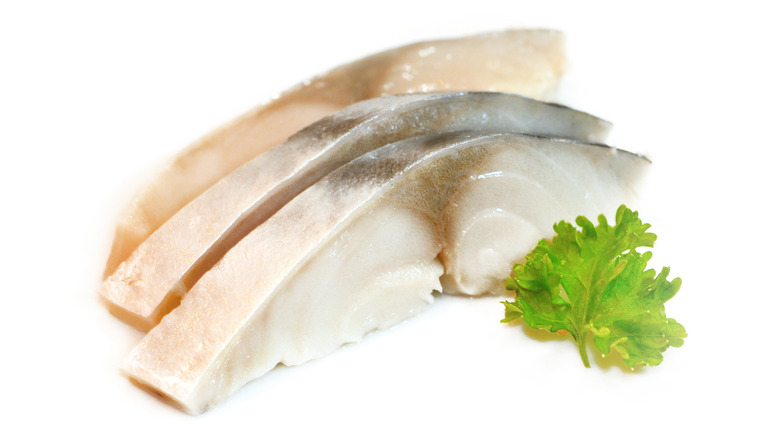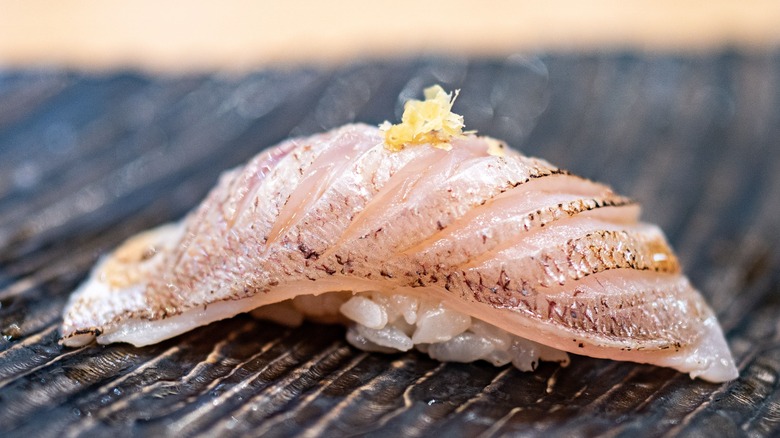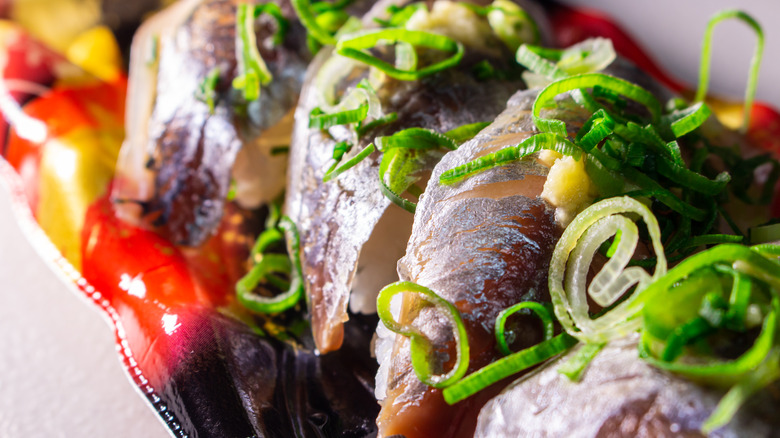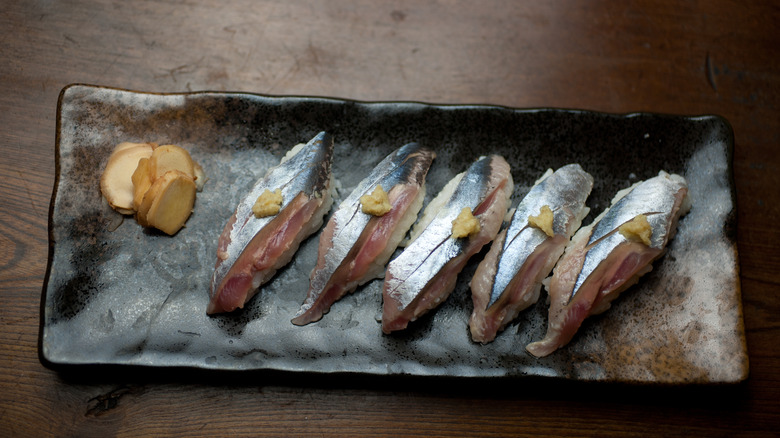A Guide To The Different Types Of Mackerel Sushi
Outside of Japan, mackerel is not usually a popular choice at Japanese restaurants. Customers may skip over it on the menu in favor of tuna or salmon, or specifically request that the silver fish be excluded from their sushi platter. Mackerel, a broader term assigned to over 30 species, often gets a bad rap for tasting particularly "fishy," and the strong flavor may linger on one's palate (or fingers) for a while. We think all this prejudice is a downright shame — mackerel is an underrated sushi option that can be truly delicious, if you get past your trepidation.
Mackerel is very popular in Japan, and as a member of the oily fish family, it's considered an especially nutritious option. Packed with omega-3s, B vitamins, and protein, these delicious fish are not only sure to satisfy your stomach, but they're good for your heart and brain, too. Fresher pieces of mackerel, which are commonly served at more upscale establishments, are subtler in flavor, but each type of preparation offers its own taste. And not all of it is fishy — mackerel can be as mild as skipjack tuna, one of the most popular types of tuna for sushi in both Japan and America. Sushi lovers should educate themselves on the various species of mackerel that they should order next time they head to their favorite spot.
Mackerel (saba)
Generic mackerel, or saba in Japanese, has been part of the country's cuisine since ancient times, but was first used for sushi during the Edo period. Edomae-style sushi is a tradition dating back to Tokyo (once called Edo) in the early 1800s. Today, mackerel is enjoyed across the country during the yearly Japanese autumn festival, when the fish have a firmer texture and more intense flavor. Saba is most commonly found in the northern and central areas of Okayama prefecture year-round.
While there are different methods of preparation and presentation, all saba has a very short shelf life. It is usually cured with salt and rice vinegar before being served as sushi. This technique was developed to avoid food poisoning, and today, it also showcases the skills of a sushi chef. The texture of saba is firm yet tender, and the flavor after pickling it is mildly sweet, salty, and sour.
Many chefs also choose to sear the fish to enhance its aroma before assembling their sushi. In addition to being served as nigiri (slices of fish on top of rice), often topped with scallions or ginger, saba can be prepared as a maki roll, with sushi rice wrapped around pieces of cured saba.
Spanish mackerel (sawara)
Sawara, also known as Spanish mackerel, is a variety of mackerel commonly found in the Gulf of Mexico and the Atlantic Ocean, though they're found in the Indian and Pacific Oceans, too. It is the largest species of mackerel among the four listed here, with the potential of growing up to 37 inches and weighing over 10 pounds.
In Japanese, this fish's kanji name combines the characters for "fish" and "spring," and it is known to be a spring-season fish across the country, even though the exact season varies from one region to another. Spanish mackerel caught in the winter season is called kan sawara, and they are thought to be the most delicious. The fish are at their fattiest in cold months, resulting in a more intense umami, buttery flavor, and supple, flaky flesh that melts in your mouth. Sawara is a decadent fish, no matter when you catch it, but it's never as rich as it is during the colder months.
Like saba, sawara may be cooked and/or preserved before it's used in sushi, whether it be in nigiri, maki, or even sashimi. If you see it served raw on a sushi restaurant's menu, be sure to try it, as this is a rare treat.
Japanese horse mackerel (aji)
Japanese horse mackerel, or aji, isn't really a member of the mackerel family. Rather than the Scombridae family that houses all "true" mackerel, this fish belongs to the Carangidae family. Its name comes from its resemblance to mackerel, rather than a true relation.
The Japanese horse mackerel is a relatively small silver fish that has a tasty subtlety and sweetness, rather than the more intense fishy flavor typically associated with mackerel. Unlike the whiter flesh of most species of mackerel, aji has a light pink hue. It's most often caught from spring through the fall, though it's at its best in the summer months.
This fish is highly cherished, and its Japanese name also means "taste," showing how widely-enjoyed it is across the country. Like other mackerel, Japanese horse mackerel is popular in Edomae-style sushi, and is a fatty, flavorful fish that is often prepared by salting and marinating in rice vinegar, just like actual members of the mackerel family. Like saba, aji sushi is often served with freshly-grated ginger and scallions to enhance the flavors.
Mackerel pike (sanma)
Mackerel pike, also known as Pacific saury, actually belongs to a separate family, too: the Scomberesocidae family. This fish is a very popular fall ingredient in Japanese cuisine — its name means "autumn sword fish" — and is at its best starting in September, when it's at its fattiest. Though the fish is used to make sushi today, it was not used in the Edomae sushi-making tradition, and was more commonly served whole and grilled.
Like saba, there are many ways to serve mackerel pike sushi. Some chefs choose to sear it, while others serve it in preserved form. Another popular option is similar to vinegar pickling: fillet the mackerel pike, then salt and pickle the exposed flesh with yuzu or another citrus juice before laying the fish on top of sushi rice. The taste can be described as similar to saba, but slightly turned down, with a lighter flavor overall. Sanma is a good choice for those of us who are curious but hesitant about mackerel sushi.

